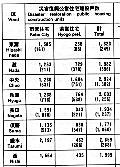Supporters Network for Community Development "Machizukuri"
 back
back  index
index  next
next
6. Maldistribution of Housing |
Housing reconstruction does not follow a fixed pattern in the earthquake damaged areas, but rather differs greatly by region. A seriously problematic gap is emerging between supply and demand for housing, whether constructed independently by individuals, by the private sector, or by public rental housing suppliers. Since there are not enough units of Disaster Restoration Public Housing, in particular, being constructed in the areas to which temporary housing residents want to move, many are complaining of mismatched supply and demand.

|
|
Table-6 Condition of housing reconstruction by district in Kobe City (3 years after)
|
Table 6 shows the number of buildings destroyed by the earthquake and the number of reconstructed buildings, which include both private and public housing. Active construction is taking place in the eastern areas, which have a good infrastructure and high potential for residential development, and the number of housing units being constructed is approaching the number of units that were originally destroyed. The number of constructed housing units alone might suggest that housing reconstruction in these areas has been completed, but serious problems associated with the current economic recession have appeared, as suggested by the appearance of vacant private rental units and unsold condominiums resulting from an excess housing supply.
In the western areas, however, overall housing construction is sluggish, with Nagata Ward showing a housing construction rate of only 57.3%. There are several reasons for this, but one is that land readjustment projects and redevelopment projects are in progress across a wide area that sustained major damage, and the preliminary steps required before construction starts take time to complete. Another is that, in high-density regions, the road condition is in adequate and there are a lot of extremely small plots of land on which buildings cannot be reconstructed because of difficulties in complying with the current Standard Building Law.
Besides, elderly earthquake victims often lack the resources and/or the desire to reconstruct. (The western areas have more low-income and elderly residents.) To stimulate housing reconstruction in the western downtown region among residents there, generous aid structures must be implemented. These should include the relaxation of regulations allowing for the Building Standard Law to be more flexibly applied, an easily accessible financing system, and a system of coordinators who can act as advocates of elderly earthquake victims until their reconstruction efforts are completed.
Availability of Disaster Restoration Public Housing

|
|
Table-7 Number of constructed units and application rate of disaster restoration public housing in Kobe
|
Table 7 shows the supply of low-cost public rental housing, such as Disaster Restoration Public Housing, by ward. The supply is inadequate in the western part of the city where the damage to nagaya and mokuchin was especially severe, and the application rate is high. The gap between the supply and demand in particular locations (the "mismatch") was anticipated to some extent in the Three-Year Housing Reconstruction Plan.
Since such large quantities of public rental housing would be needed three years after the quake, there was no choice but to acquire amount of suitable land in the established outlying areas in which the acquisition of land immediately after the quake had been relatively easy. Originally there was little land available in the damaged areas for housing construction of sizable multiple family housing complexes. This fact, together with unanticipated hurdles like the need to dispose of debris from collapsed structures and the changing shape of the land caused by earthquake tremors, limited the speed with which usable land could be obtained. This affect the west side more than the east side.
Over time, more and more efforts were made to eliminate the "mismatch". Public housing was provided in the disaster stricken areas through rentals and purchases of semi-public and private housing. The new site of the JR Takatori yard is being targeted to undergo land readjustment, and the construction of housing and infrastructure are under way.
Three and a half years after the earthquake, there are still approximately 1,400 temporary housing resident households hoping to move into public housing facilities. Although this does not mean that the "mismatch" has been eliminated, diligent efforts are being made to utilize vacant public housing units as they become available over time and to rapidly eliminate temporary housing facilities.
 back
back  index
index  next
next
Mail toSupporters Network for Community Development "Machizukuri"
(C) by Supporters Network for Community Development "Machizukuri"
Supporters Network for Community Development "Machizukuri"(Japanese Only)
Gakugei syuppansya HP(Japanese Only)
 back
back  index
index  next
next

 back
back  index
index  next
next